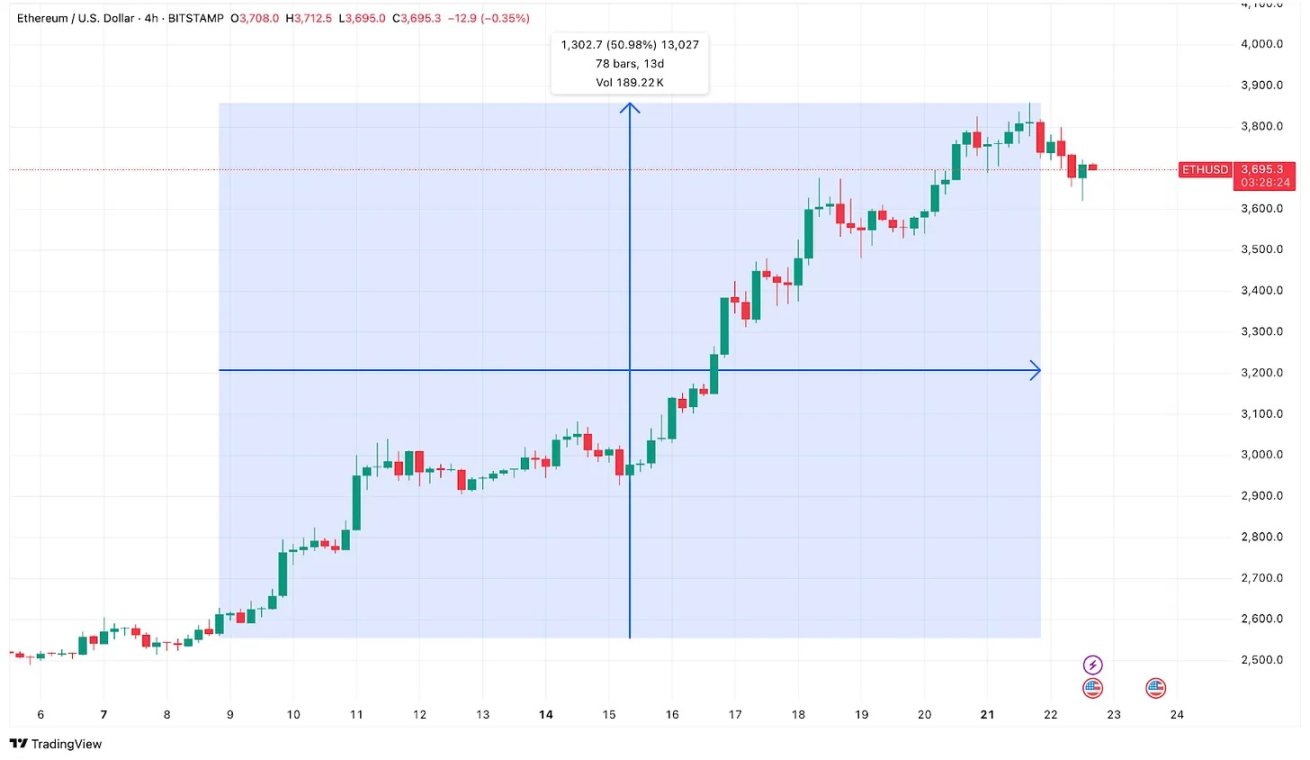Ethereum ETF One Year Ago: From Cold to Hot, the Confidence of Institutions Behind the Flow of Funds Changes
Original article by Prathik Desai
Original translation: Saoirse, Foresight News
Three months ago (Ethereum ETFs were not optimistic due to significant capital outflows, low market attention, and insufficient yield advantages), even for Ethereums most ardent supporters, it seemed like a fantasy to celebrate the first anniversary of Ethereums exchange-traded fund (ETF) in the United States.
However, the Ethereum ETF is now having its own highlight moment – it has been a full year since it first started trading on July 23, 2024.
In June 2025, the Ethereum ETF had its best monthly performance ever, with inflows exceeding $3.5 billion, 70% higher than the previous peak of $2.08 billion in December 2024. July has seen even stronger inflows, exceeding $3 billion so far, and is expected to surpass June. The past two weeks ending July 18 were the best two weeks for net inflows, and there has been no net outflows for ten consecutive weeks, which is the first time in its 52-week life.
The “hockey stick” growth curve in the figure below is a vivid portrayal of this trend.

But the development of Ethereum ETF has not been smooth sailing.
In May 2024, US regulators approved the Ethereum ETF, which officially started trading on July 23 of the same year. At the time, the market reaction was mixed. After all, Bitcoin ETF had already grabbed all the spotlight at the beginning of the year, and the debut of Ethereum ETF seemed uneventful: the price trend was sluggish, the attention gradually decreased, and there was no large-scale capital inflow in the early stage of its launch.
In fact, some of the initial capital flows even showed net outflows.
In the first 39 weeks of trading, the Ethereum ETF only achieved net inflows in 15 weeks; compared with the past 14 weeks, there were 13 weeks of net inflows, which shows the huge change in the wind direction in the past three months.
As of July 21, 2025, the assets under management (AUM) of all Ethereum ETFs in the United States have exceeded US$19 billion, doubling from approximately US$9.6 billion two months ago.
Not only ETFs, institutions interest in Ethereum is also accelerating in the form of Ethereum reserve assets.
On June 2, 2025, SharpLink Gaming became the first US listed company to announce the inclusion of Ethereum in its strategic reserves. While the 加密貨幣 community is still watching a number of listed companies add Bitcoin to their balance sheets, Joe Lubin has brought Ethereum to the reserve asset party.
As the co-founder of Ethereum and the founder and CEO of Consensys, Lubin joined the board of directors of SharpLink Gaming as chairman and led the companys $425 million Ethereum strategic reserve.
Since the launch of the reserve asset program, SharpLink has become the worlds largest enterprise-level Ethereum holder, holding 360,807 ETH, worth more than $1.3 billion at current prices. In addition, the company has raised an additional $413 million in financing and received a total of 567 ETH in rewards by staking its Ethereum holdings.
Moreover, in the supplemental prospectus submitted to the US SEC, SharpLink requested to increase the sale amount of its common stock from the initially reported US$1 billion to US$5 billion.
However, a new company that is developing Ethereum reserve assets is competing fiercely with it.
Bitcoin mining company BitMine Immersion also bets on Ethereum, holding more than 300,000 ETH, worth more than $1 billion at current prices. Its chairman Tom Lee is a veteran of Wall Street, and he has a bigger goal:
We are steadily moving towards our goal of acquiring and staking 5% of the total supply of Ethereum. Currently, the total amount of Ethereum held by SharpLink and BitMine exceeds that of the Ethereum Foundation.
Overall, the flow of funds to Ethereum reserve asset companies and ETFs together reflects the investment confidence of institutions in Ethereum as an infrastructure layer, and this confidence is still growing.
Cathie Woods ARK Invest recently reduced its large holdings in Coinbase and Roblox and increased its holdings in BitMine Immersion by $182 million. ARK previously had insufficient exposure to Ethereum and restructured its three flagship ETFs, allocating 1.5% of its portfolio to BitMine.
Billionaire Peter Thiel also owns a 9.1% stake in the company.
Ether Machine, the new company formed through the merger of existing companies, will create a public trading platform to provide institutional investors with professional-grade channels to access Ethereum infrastructure and Ether returns.
The company was co-founded by Andrew Keys, former board member and head of Consensys, and David Merin, former Consensys executive and current CEO of Ether Machine. After the merger, Ether Machine plans to be listed on the Nasdaq, and will hold more than 400,000 ETH, worth more than $1.5 billion.
What has changed in the past few months? The recent leadership changes at the Ethereum Foundation may be one of the reasons.
At the end of April 2025, the Ethereum Foundation made leadership adjustments and separated the board of directors from the management. The new leadership identified three core priorities: expanding the Ethereum base layer, optimizing Layer 2 Rollup (second-layer expansion solution), and improving user experience.
Ethereums practical value and profitability also make it an extremely attractive target in the eyes of investors.
Currently, there is no ETF in the United States that provides staking rewards, and the U.S. Securities and 交換 Commission (SEC) has not yet approved it. If the Ethereum ETF can eventually launch the staking function, ETH is expected to become a digital bond in institutional investment portfolios.
ETFs that support staking may provide a native return of 3%-5%. Based on the current $19.6 billion in Ethereum holdings, even with an average return of 4%, ETF issuers can earn more than $750 million in staking income.
BlackRock is already exploring product structures that include pledges, and its 19 b-4 amended filing explicitly states that pledges are a potential future feature subject to regulatory approval, and the market is waiting to see what happens.
Experts predict that the staking function of the Ethereum ETF is expected to be approved in the fourth quarter of this year.

@JSeyff
For many investors, staking may be the key difference between shallow allocation and deep participation. Passive income obtained through compliant investment tools may attract pension funds, endowment funds and sovereign wealth funds to enter the market.
In a report released when the Ethereum ETF was launched last year, market maker and trading company Wintermute pointed out that the lack of a staking mechanism is a major shortcoming that may weaken the attractiveness of Ethereum as an ETF vehicle.
If the macro environment changes, such as interest rate cuts, stabilization of inflation, or capital seeking higher returns, Ethereum will become a very competitive option: it combines the scarcity of supply deflation, the profitability brought by staking, and easy access through ETFs and custodians.
Ethereum prices have been linked to institutional activity. Further price breakthroughs could trigger market optimism and attract more capital inflows. In any case, after a long period of silence, the evolution of Ethereum will be welcomed by both retail investors and institutions.
In the past two weeks, the price of Ethereum has soared by more than 50%, setting a new high in 2025; the cumulative increase in the past three months has reached 150%.

When an ETF issues new shares, it must buy ETH, which locks in supply. The reduction in ETH circulating in the market will put upward pressure on prices.
It is expected that Ethereum reserve asset companies will also firmly hold ETH. Registered investment advisors (RIA), wealth management institutions and listed companies usually do not pursue short-term gains and rarely panic sell.
Reserve asset builders are positioning ETH as programmable collateral, an asset that generates yield, provides security, and remains stable.
In addition, the macro backdrop is also positive: the GENIUS Act was recently signed into law, legalizing stablecoins as digital cash. Ethereum, as the dominant network with a 50% market share, will be the biggest beneficiary.

So, how will the future develop?
Once the SEC approves the ETF staking function, institutional interest is expected to continue to heat up. More companies may establish Ethereum reserve assets due to the staking function, and asset management institutions such as BlackRock will further increase their investment allocation in Ethereum.
For traditional investors, they may realize at this moment that Ethereum already has two powerful circulation channels: ETFs and reserve assets. Both lock up the supply and expand Ethereums influence into the traditional economic field.
Those who directly compare Bitcoin and Ethereum as reserve assets and ETFs are missing a core difference:
Bitcoin is seen as a store of value and a digital gold in macro strategies, while Ethereum is given practical uses. Fund issuers and reserve asset builders buy and support ETH because of its added value: staking rewards, infrastructure framework, and as a programmable layer for financial applications.
Bitcoin is a holding asset, while Ethereum is an application network.
This article is sourced from the internet: Ethereum ETF One Year Ago: From Cold to Hot, the Confidence of Institutions Behind the Flow of Funds Changes
Related: XRP breaks new highs, the encrypted parallel world behind the fierce old currency
Original author: TechFlow Between the ups and downs of each round of crypto market, there are always some familiar names that appear repeatedly on the list of gains. XRP, XLM, ADA… These projects, which are regarded as without future in the mainstream crypto circle, are still regaining their presence today in the wave of a new bull market. They are not new innovative public chains, nor are they the hottest newcomers with hot narratives, let alone any strong ecosystem or technological breakthroughs. But at a certain stage in the bull market cycle, In some inexplicable way, they always rise against the trend, return to the center of traffic, and even break new highs like XRP. This is not just hype inertia in the financial market, its more like there is…







